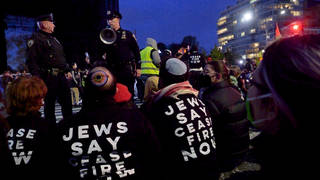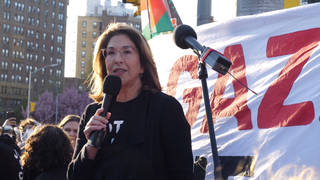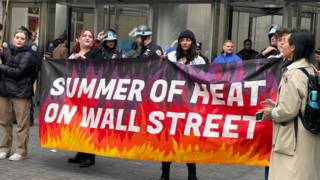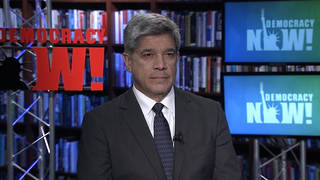
Related
On the heels of what is being called the largest day of protest in U.S. history, where does the immigrant rights movement go from here? We discuss the significance of the May Day marches and the future of the movement with two organizers. [includes rush transcript]
On the heels of the massive May Day immigrant rights marches, where does the movement go from here? To help us recap this historic day and look at what’s next, we speak with two organizers of Monday’s actions.
- Javier Rodriguez, a longtime immigrant rights activist and spokesperson for the March 25th Coalition Against HR 4437, the umbrella group that organized one of the two marches in Los Angeles and spearheaded the nationwide economic boycott.
- Justino Rodriguez, student organizer with the newly formed CUNY Coalition For Immigrant Rights. Their walkout drew nearly 2,000 students from the City College of New York alone.
Transcript
AMY GOODMAN: On the heels of such a massive turnout, where does the immigrant rights movement go from here? To help us recap this historic day and look at what’s next, we’re joined by two organizers on both sides of the country. Joining us from Los Angeles, Javier Rodriguez, longtime immigrant rights activist, spokesperson for the March 25th Coalition Against HR 4437, the umbrella group that organized one of the two marches in Los Angeles and spearheaded the nationwide economic boycott. And in our Firehouse studio we’re joined by Justino Rodriguez. He’s a student organizer with the newly formed CUNY Coalition for Immigrant Rights. Their walkout on Monday drew nearly 2,000 students from the City University of New York alone. And we welcome you both to Democracy Now!
First, the numbers. You know, it’s always hard to estimate this, especially nationally, Juan, but when they say tens of thousands or perhaps thousands in New York, I walked the entire breadth of the march from the courthouse to Union Square, and I never stopped seeing people walking. And as you point out in your piece, Juan, the people in these rallies across the country — sometimes I feel like I’m at a daycare rally, there are so many children. I mean, infants in strollers, kids waving their American flags. You see whole families that are marching along arm in arm. I had never seen anything like this in protest in this country.
JUAN GONZALEZ: Yes, that’s true. The number of entire families that you see marching together, because — again, people do not realize the depth of suffering that many of these immigrants have been going through for so many years, separated from loved ones, unable to, because, as the immigration laws have gotten tighter, the ability of people to even visit family in their homelands and come back has become less and less, so they feel, as that song from Los Tigres del Norte, “Even though it’s a jail of gold, it’s still a prison” that America has become for immigrants. But I would like to ask Javier in Los Angeles what the crowds were like yesterday, and also is it the same sense there of whole families participating in these marches?
JAVIER RODRIGUEZ: Absolutely, Juan. It was a wonderful great joyful day, peaceful. And let me say this, Juan. We estimate that several million people participated in the boycott just in Los Angeles alone. Yes, we had over a million people, perhaps a million-and-a-half, maybe two million people just in our march alone in downtown, plus a half a million or more. Whatever it was, it was a lot of people, but that was the most visible.
But in terms of the boycott, we shut down Los Angeles, we shut down Southern California all the way to San Diego. You could feel it in the ports, the garment district, the flower district, the restaurants, city halls were shut down, you name it. You name it, all you had to do was walk down — the most visible were the small business. Half of the business of the nation, meaning half of the business, rather, of Los Angeles who employ half of the people in the city were shut down in most of the neighborhoods. It was extremely, extremely beautiful.
But let me also say that it wasn’t just local or national. It was also international. The border — the 2000-mile border, it was shut down by Mexican people on the other side, and there was also a national boycott called in Mexico that it’s estimated at tens of millions that boycotted McDonald’s, Wal-Mart, and so on, and so on.
JUAN GONZALEZ: Well, Javier Rodriguez, one of the interesting issues that arose in the last few weeks was that many of the church leaders and union leaders and even political leaders that had participated in the April 10th protest stayed away from the call for the May Day boycott, and yet the people came out anyway. And your sense of where the people are versus where some of these leaders are?
JAVIER RODRIGUEZ: Well, on March 25th, Juan, when we had over a million people in Los Angeles, we knew we were going to put out the call, and we did on that day. On that day, we said, “Today we march, tomorrow we boycott.” And it was taken on, because it’s the lifelong dream of the immigrant population, especially of Mexicanos, Dominicans, Colombians, you name it. It’s like the movie showed us, A Day Without a Mexican, that was truly a day without immigrants, and it’s a deep feeling. It’s almost spiritual. It was solemn to go down the street from 4:00, 5:00, 6:00 in the morning to see the nanny train empty. Empty. I mean, the wealthy neighborhoods, the middle class neighborhoods had to do without the nannies, without the women having to take care of the old, of the sick, and so forth. It was something.
AMY GOODMAN: Justino Rodriguez, talk about New York. I don’t think it’s quite as organized as Los Angeles in the sense of the formal groups.
JUSTINO RODRIGUEZ: Right. I mean, there’s an immigrant rights leader out on the West Coast, Nativo Lopez, who talks about the fact that this is a movement without leaders, and I think he encapsulates it completely, because the immigrant rights movement in general has been organized from the bottom up. We’ve seen, like, individuals just going around, organizing their workplaces. I spoke to construction workers on Sunday who said they were organizing their workplace, bringing 40 people to the protest. I saw, you know, in Washington Heights, which is a neighborhood in Manhattan that’s predominantly Dominican immigrants, restaurants were shutting down.
And I think the one thing about it is they have a little bit of a jump on us, I think, on the West Coast, where they’ve been — the different immigrant rights organizations have been coming together and organizing, and they have a network established. And I think that that’s one of the strengths that they have in terms of, like, battling the Minutemen. They’ve been able to develop that.
I think that we need — it’s going to be of complete importance for us to develop those networks here, specifically within the context of the Department of Homeland Security stepping up the ICE raids, attacking immigrants, going into workplaces arresting undocumented workers. We’re going to need to establish, I think, an emergency response network, and also like a networking of the different immigrants rights organizations.
AMY GOODMAN: I want to stop you there, when you talk about ICE raids. Explain. And for people — I mean, we live in two different Americas, and for some it’s the greatest democracy on earth, for others it’s a very difficult place right now. I think a lot of people won’t even know what you mean by the acronym ICE.
JUSTINO RODRIGUEZ: Right, and unfortunately it’s an acronym that strikes a lot of fear in a lot of undocumented immigrants. Basically, what’s happened over the last couple of years is basically the immigration control organizations of the government —
AMY GOODMAN: The new I.N.S., ICE.
JUSTINO RODRIGUEZ: The new I.N.S. has emerged with the Department of Homeland Security, and it’s now being controlled by them, and so basically they’re conducting the same job, and now they’re conducting it under the veil of the war on terror, as well. And so basically what they’ve done is I have a friend, for example — and I think we’ve seen the more — you know, Michael Chertoff came on the news about a week ago with, like, one of the major companies that they’re going after in terms of not only going after the workers, but also going after the corporation. What ICE has been doing, which is the new I.N.S., has been going around to workplaces and detaining and deporting immigrants, and I think that basically what’s being done, this is being done, I think, in response to a rising movement. They’re trying to intimidate immigrants, force people from coming out on the streets, and I think that what we’ve seen from New York to L.A. is the immigrant rights movement will not be deterred.
AMY GOODMAN: Your aunt’s workplace hit?
JUSTINO RODRIGUEZ: A friend mine’s aunt’s workplace. It’s a window pane factory in New Jersey, which was surrounded by ICE while they were out on lunch, and I believe some people were deported, and people weren’t allowed to come back to work for the day. And I think that this is actually a phenomenon that’s not isolated to just New Jersey, but it’s happening across the country.
JUAN GONZALEZ: What about the university students? You’re at City College, what has been in recent weeks and months the tenor of immigrant students at the colleges and the level of involvement that they’ve had?
JUSTINO RODRIGUEZ: I think we were completely inspired and invigorated by what we saw the youth and student wing of the immigrant rights movement do on the West Coast, you know, with 20,000 students coming out and blocking traffic in L.A. I think that specifically within CUNY there are 10,000 undocumented immigrants that attend the City University of New York system, so I mean, I think that in the general context of the different legislation attacking immigrants, I think there’s also an attack on immigrant students, where you see undocumented students in the City University of New York system paying double the tuition of people who have their citizenship. I also think within that, they don’t receive financial aid, so I think that there was a lot of anger, and we were able to successfully both for the April 10th event, we mobilized 1,500 community students to come out, and now for the protest yesterday, we had about 2,000.
AMY GOODMAN: Javier Rodriguez, what about the students in Los Angeles?
JAVIER RODRIGUEZ: The students in Los Angeles came out. According to official reports, about 27%, 30% probably in some — this is overall, but in some areas there may have been as high as 60%, 70%, or even higher. They were out there, no doubt about it, in both marches.
Amy, let me mention this. The boycott, the boycott was a call for no work, no school, no purchasing and no selling. So it had four dimensions to it. In that context, it’s going to be fascinating, the reports that may come down. We don’t know if it’s a fact yet, but according to some, either rumors, the stock market may have gone down a sizeable amount as of yesterday, late yesterday. So we’re going to be watching that in terms of commerce, in terms of trade, in terms of production, in terms of construction, and, of course, in terms of the students, the reports when we get them from the rest of the counties, the school systems here in California.
JUAN GONZALEZ: And Javier Rodriguez, your response to those who say that the May Day protests will unleash a backlash in middle class America and also what the plans for the movement are for the future?
JAVIER RODRIGUEZ: Well, Juan, for the third time in, what, two months, we have galvanized the country, up to March 25th, April 10th, and now May the 1st. The response to them and, you know, it goes all the way out to Mexico and Mexico City, those kind of observations, negative observations by President Vicente Fox, and the response is clear. The marches have been peaceful. The boycott was very peaceful and also very effective.
And I think the rise in the opinion polls in support of legalizations is the clearest example and the clearest thing we can send in terms of a message to the country, to the naysayers, to the moderates that were — I mean, you cannot imagine how they campaigned against the boycott here in Los Angeles, and you saw Cardinal Mahoney meeting with the devil, Karl Rove, and also with President Bush, and President Bush called on Americans to not respect the boycott. Yes, to the naysayers, we tell them that we were extremely successful.
The immigrant community and the rest of the population who sees —- let’s say that they are seeing the strategies, the tactics that we are employing in this campaign, that can be applied in terms of oil prices, in terms of gas prices, in terms of getting back at corporate America and also the administration, the extreme rightwing administration, which we feel we’ve dealt another absolute blow. Now in terms of what’s next -—
AMY GOODMAN: I’m going to stop you their, Javier Rodriguez, for a minute. We have to break, and then we’re going to come right back, and we’ll also be joined by labor activist and journalist, David Bacon, to talk about how the story of immigration in this country ties in with the trade agreements of the hemisphere. We’re talking to Javier Rodriguez on the West Coast in Los Angeles. We’re talking with Justino Rodriguez here in New York, a student organizer of the protests here.
[break]
AMY GOODMAN: We’re joined on the telephone by David Bacon, veteran labor journalist who writes for a number of publications, including The Nation and The Progressive. He’s also a programmer on Pacifica station KPFA in Berkeley, author of a number of books, including The Children of NAFTA. His new book will be called Communities Without Borders. He was in Los Angeles yesterday. Our guest in studio are Javier Rodriguez in Los Angeles and Justino Rodriguez here in New York. David Bacon, thank you for joining us. Can you link what we’re seeing in this country, millions of people on the streets in this latest May Day protest, to the greater story of the trade agreements in the Americas?
DAVID BACON: Sure, Amy. In fact, I think a lot of the people in the two huge marches here in Los Angeles did that themselves. For the first time, I saw lots of people carrying signs that said “no guest worker programs,” and this is, I think, different and something that went beyond what we’ve seen before, because, really we’ve been told now by Congress for quite a while that the only alternative to the odious Sensenbrenner bill, which would criminalize 12 million people is to allow Congress, the Senate specifically, to pass enormous guest worker programs and, in fact, force people who are here without papers to become guest workers as the price of legalization. And there were many, many people, including speakers up on stage also condemning this idea.
Really, what’s going on here is that the trade agreements, like NAFTA, and this neo-liberal free trade regime is displacing enormous numbers of people around the world so that worldwide there are about 170 million people living outside the countries in which they were born, and overwhelmingly this is due to the kind of enforced poverty that this free trade regime is producing.
But what is really kind of new here is that the corporate elite, large corporations, are now seeing this flow of people as something that can be used as a whole new source of profit, so that we see proposals for programs, like guest worker programs, in a number of different countries. In Britain, for instance, this is called “managed migration,” and we see the same thing in Europe and, in fact, at the W.T.O. negotiations in Hong Kong, there was a formal proposal introduced called Mode 4, which essentially would set up a huge new international guest worker program. So migration has always been part of the free trade regime, because of the fact that the imposition of this regime displaces people, but now it’s becoming even more a part of this regime, because really in a sense the International Monetary Fund, the World Bank, financial institutions, large corporations see migration itself as being something that they can turn into a profit.
JUAN GONZALEZ: David, among the national leaders who have participated in some of these demonstrations, Jesse Jackson has been one of the few, as he spoke at yesterday’s rally, who has linked the issue of globalization and the increasing emphasis on mobility of capital, while at the same time these constant restrictions and walls put around labor’s ability to be mobile. Your sense of how the political leadership in the country is trying to, in essence, restrict this debate around sort of catch phrases that create heat, but not much light, on the issue?
DAVID BACON: Well, I think Jackson and the AFL-CIO both, for instance, first of all, they accept the existence of this flow of people. In other words, you know, as opposed to restrictionists in this country who would say, “Well, okay, let’s try and stop it,” which is not only impossible, but leads to, you know, really very repressive measures like the Sensenbrenner bill. What they’re saying is people need to be free and equal. So the proposal, for instance, from the AFL-CIO is saying, essentially, people need green cards.
In fact, I think this is what people out in the streets are saying, as well, too. You know, you see signs that say not only — you know, we want equality, but signs that say we want amnesty, and what people are saying when they use the word “amnesty” is not forgiveness for a particular crime, but simply the idea that, as in 1986, that the only way to resolve the situation of the people who are here without papers is simply to give people papers, in other words, to give people green cards.
So, I think this is the way in which people like Jackson, people like the AFL-CIO are envisioning that we can both recognize the flow of people that’s coming across borders and offer people some opportunity to be parts — you know, be equal here in this country, as opposed to the kind of second-class status that would be imposed on people by this kind of corporate program. But clearly, we also need to take a look at the kind of free trade treaties and the kind of free trade regime that we have set up around the world and begin to dismantle it, because until we kind of undo the unequal arrangements that are imposed by NAFTA and CAFTA and the Free Trade Area of the Americas and the structural adjustment programs that enforce poverty on countries around the world, then this flow of migrants, this forcible flow of migrants, is not going to stop. [inaudible] people in other countries are doing that, too.
AMY GOODMAN: David Bacon, I wanted to ask you, David, in Bolivia, the president, Morales, marked May Day by announcing the nationalization of the country’s natural gas fields and refineries. The Bolivian government has also just agreed to join a new trade pact with Cuba and Venezuela. Morales signed the agreement in Havana, where he meet with Venezuela’s President Chavez and Cuba’s Fidel Castro. The countries are hoping that Latin American nations will defy the United States and join what they call the Bolivarian alternative for the Americas. How does that compare to NAFTA?
DAVID BACON: Well, I think that is the alternative. In other words, development, economic development in countries from Bolivia, Cuba, Venezuela, and eventually, I think, Mexico, too, of, you know, economic development to benefit the residents of those countries, rather than for the profit of foreign corporations that invest in those countries in pursuit of, essentially, low wages. So what they’re doing is they’re presenting an economic alternative, and I think that for people who support the rights of immigrants here in the United States, I think this is something that we seriously have to take a look at, because until countries in Latin America, for instance, are free to be able to establish a course of economic development which lifts the living standards of their own people without, you know, the pressure of the I.M.F. and the World Bank and the United States trying to enforce poverty as a means of profit for corporations. Until countries are free to do that, people will continue to be displaced. And, of course, where do we think, you know, the people displaced by structural adjustment programs are going to go?
JUAN GONZALEZ: And finally, Javier Rodriguez, we only have about a minute left but could you give us a sense of where the movement, the immigrant rights movement will go from here?
JAVIER RODRIGUEZ: I believe, Juan, that we’re going to cautiously await the next few days in order to find out what the response is going to be from the establishment, from up in Washington, just as we did after March 25th. Then, they put legalization on the table. We’re going to see if there’s been any improvement on their vision. The other is that we’re going to see what the people want us to do. We’re going to be polling, you could say, talking to the people themselves and see where we go.
AMY GOODMAN: Juan, just one point here in New York. We watched and played for our viewers and listeners, politicians addressing these massive crowds. There’s nothing a politician likes more, unless they’re protesting against them. So you had Obama, Senator Obama in Chicago, as well as Congressmember Gutierrez; in Los Angeles, the mayor, Villaraigosa, of course, is very much a part of this; but here in New York, where are the so-called leaders?
JUAN GONZALEZ: Well, yes. But in Los Angeles the mayor was not supporting the boycott, but he did come out for the rally.
AMY GOODMAN: But even people in New York who were not boycotting were there for the rally.
JUAN GONZALEZ: Right, but you had a situation in New York, where Hillary Clinton on April 10th spoke at a big rally, and immigrants — then the following day, she comes out in strong support of this new version of the Chinese wall, the Great Wall of China, right here in the United States, so that you have these politicians that are attempting to play both sides of this issue in different constituencies, and most stayed away, except for the members of the black and Latino and Asian caucus of the state legislature of New York, who amazingly walked out of the legislative session and forced it to close down today, and one of them did speak at the rally — Adriano Espaillat — but other than that, there were virtually no politicians at the New York rally.
AMY GOODMAN: Justino, last comment.
JUSTINO RODRIGUEZ: Yeah, I think there was also a specific dynamic about it. I think there was a little bit of a slip beginning to form, like some of the central demands of the march yesterday in New York was “amnesty now,” and I think that there’s a little bit of a split in terms like what the politicians are trying to advocate and what the demands of the movement are. We’ve been talking about that. I think the grassroots wants amnesty. This is what they want, and I don’t think the politicians are ready to give them that, and I think that they’re not ready to come out in support of the movement in that respect. They want a guest worker program.
AMY GOODMAN: Well, I want to thank you all for being with us. David Bacon, labor journalist, has written the book, Children of NAFTA. Justino Rodriguez, thank you for being with us here in New York, and Javier Rodriguez, one of the leaders of the protest and boycott in Los Angeles.











Media Options